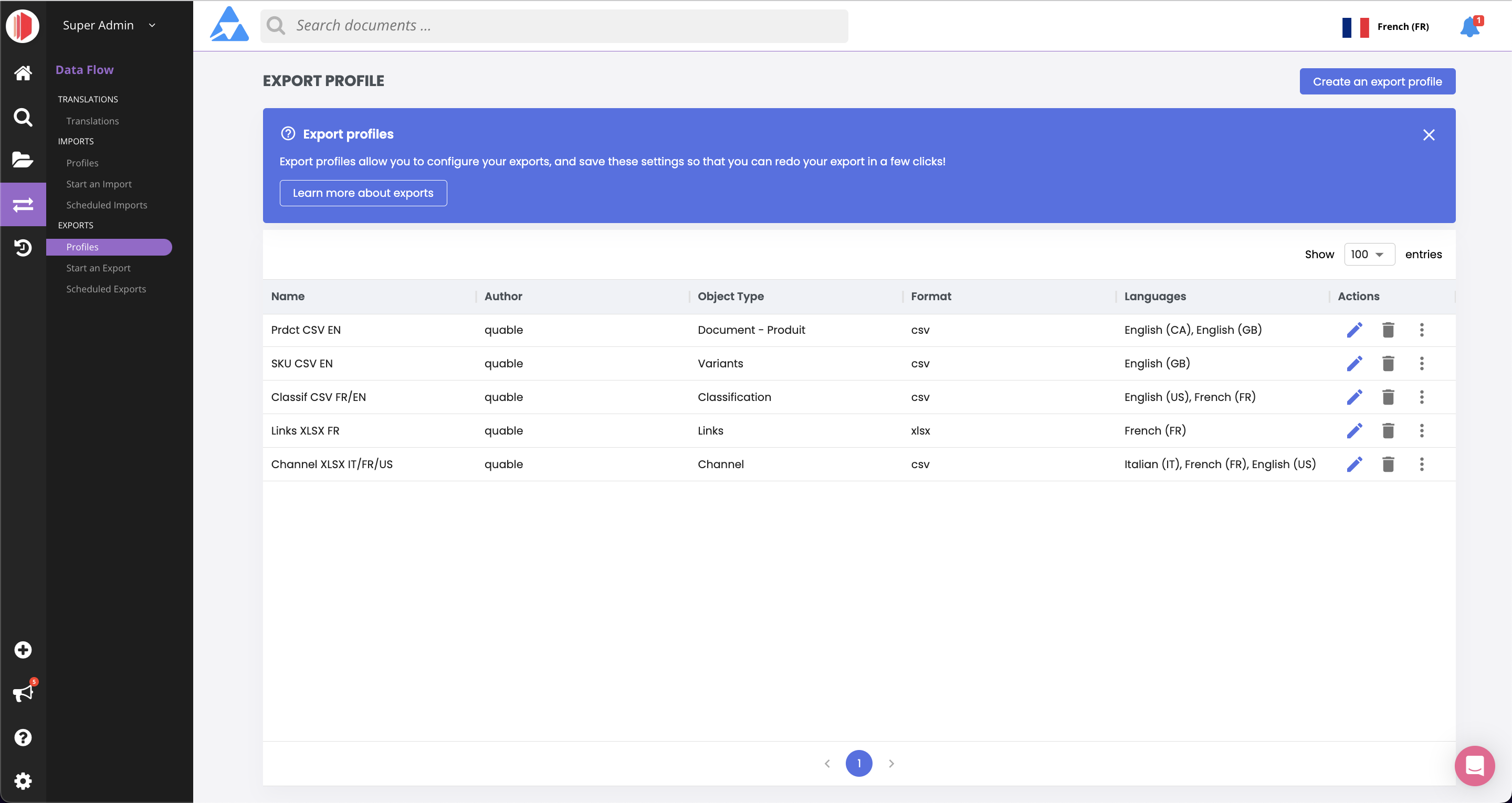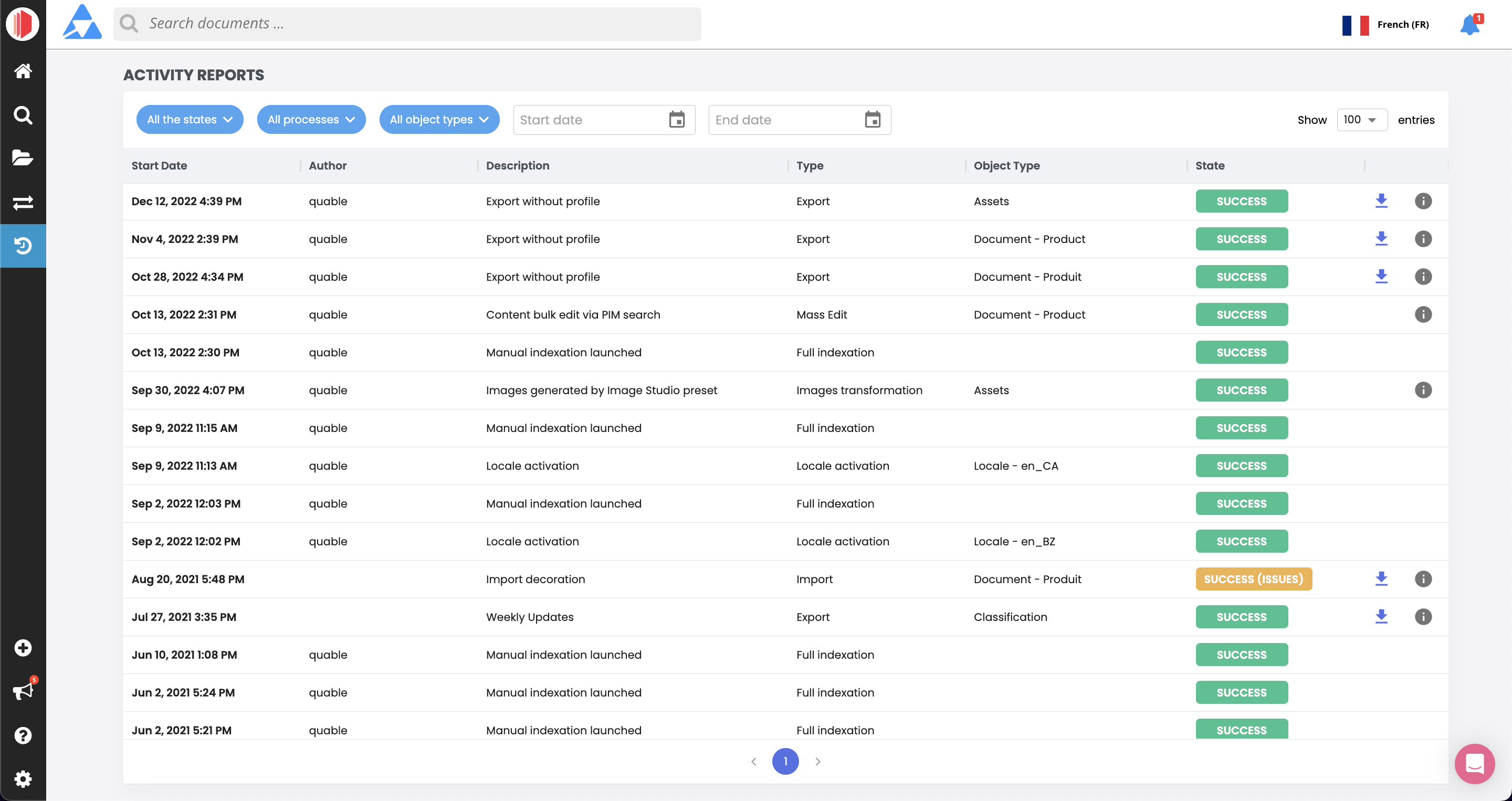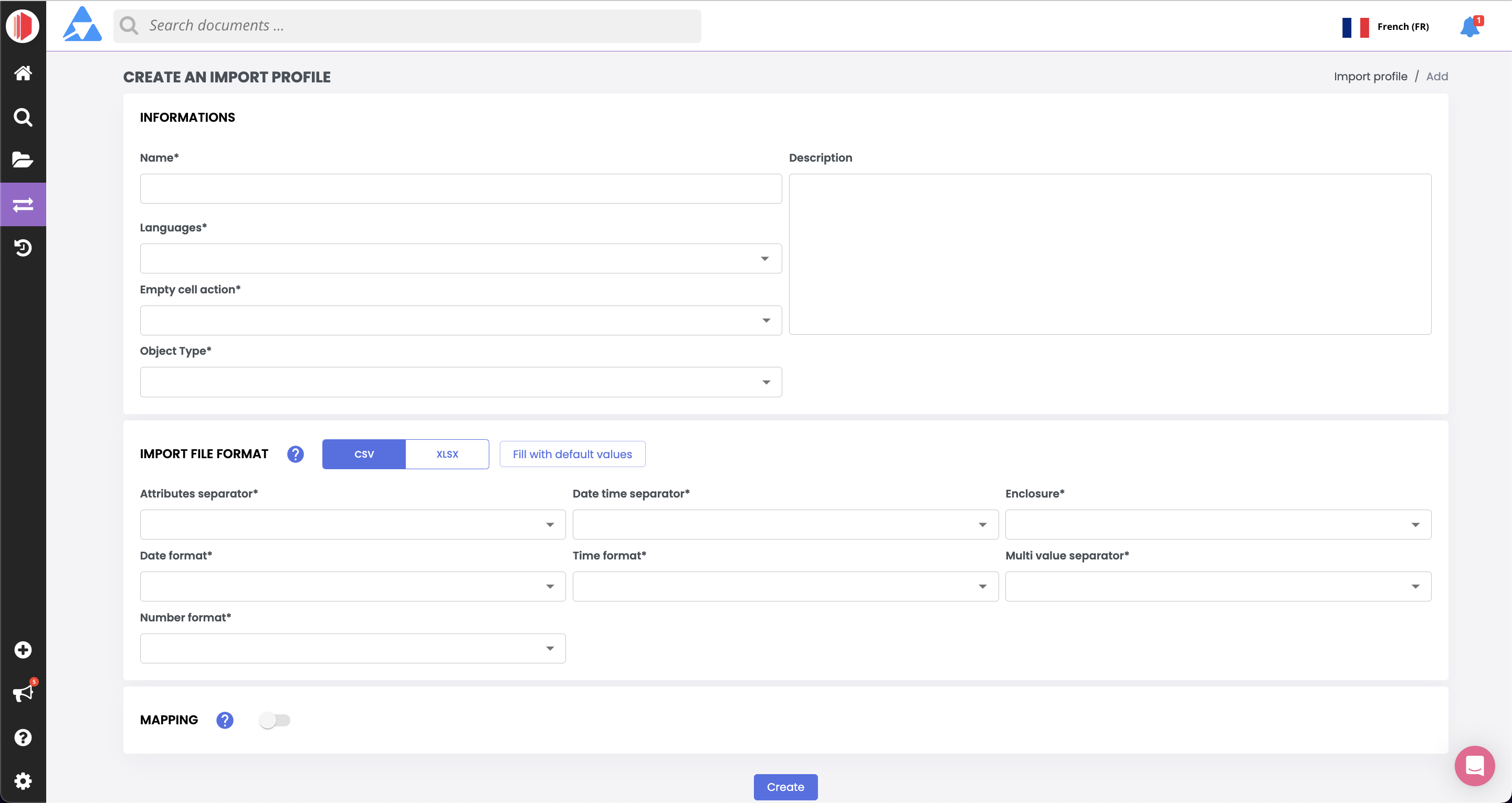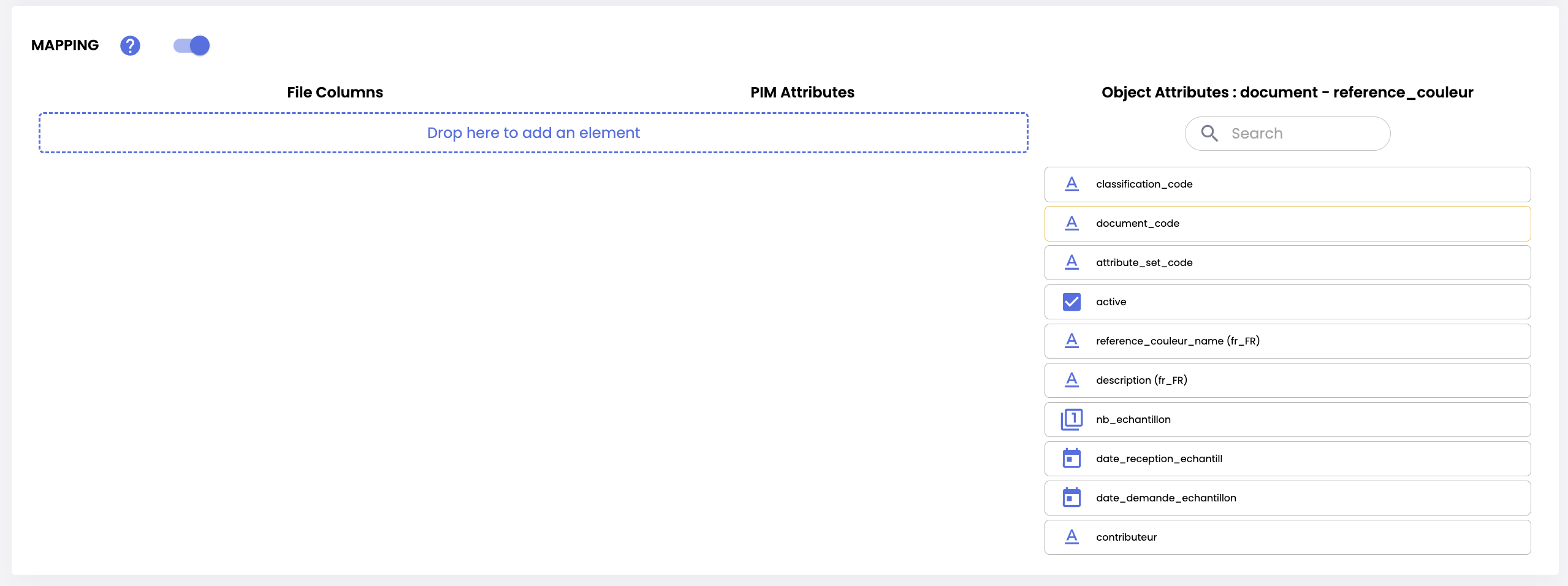Profiles
Frequently export the same type of file? Save your preferences!
The Export Profiles page is where you can define and manage the profiles for your Quable PIM exports. The page includes a brief description of the feature, a link to this documentation page, and a list of existing export profiles, if any.
-
If no export profiles have been created yet, a Create Profile button is displayed in both the Current Export Profiles section and the top right corner of the page.
-
If export profiles have already been created, a list is displayed with: the Name of the profile, the profile's Data Type, the file Format (CSV or XLSX), an indication if attribute Mapping is used, data Languages, and whether or not the profile is for Remote exports. The Create Profile button is only displayed in the top right corner of the page.

At the end of each line of an export profile are icons to Edit or Delete the profile, as well as More actions. Clicking on More actions displays:

| When you click: | |
|  |
|  |
Creating Profiles
To create an export profile click the Create an Export Profile button. The Create an Export Profile form is displayed:

The form is divided into three sections: Profile Identity, Export File Format, and Mapping. These are described in detail below. When you've completed the sections, click the Create button to save the profile.
Profile Identity
This section is used to distinguish each export profile and its settings. Enter the following information:
Information | Description | Mandatory | ||||||||||||||||||||||||
|---|---|---|---|---|---|---|---|---|---|---|---|---|---|---|---|---|---|---|---|---|---|---|---|---|---|---|
Name | The name of the export profile. | Yes | ||||||||||||||||||||||||
Description | Enter text to describe the export profile. | No | ||||||||||||||||||||||||
Object Type | The type of object to use for the export. Possible values:
| Yes | ||||||||||||||||||||||||
Languages | The data language to export. | Yes | ||||||||||||||||||||||||
Export with inherited columns | Defines the action to take for data defined with a language inheritance. When language inheritances are defined, incomplete content in the exported language is automatically replaced by the corresponding content in the data language.
| Yes |
Export File Format
This section is used to specify the format and parameters (if any) of your export file. Two options are available:
|  Maximum number of lines: 200,000 To export .xlsx files, standard settings are used. You don't need to specify any parameters. | |||||||||||||||||||||||||||
|  Maximum number of lines: 200,000 To export .csv files, you have two options for parameters:
|
A new feature is available for CSV exports!
- In the custom CSV exports, you find a new option "Data for list attributes" that allows you to add to the export file: one to two columns per selected language, for each "List" attribute of the selected object type, displaying labels and/or descriptions.
- Please note that this feature is not available for .xls (excel) export file format.
Filters
Available only for document objects, once a document type is selected. This section is used to specify filters for the data to be exported. Two options are available:
- No filters (default) : All data of the selected object type are exported without any filtering
- Advanced filters
This feature is experimental and is only recommended for advanced users with JSON skills.
Quable does not provide support for its use at this time. In the field accepting Json, enter your filters.
- Filters can be for attributes, completeness, tags and workflows.
- The JSON syntax is checked, but the filters are not checked for veracity.
- Filters work in combination to create an AND statement.
- Conditional OR statements are not supported.
- If a mapping is used, the keys of your filter must match the names of the mapped attributes. You can find information on filter operators [here] (doc:filter-operator-reference).
[
{
"column": "document_code",
"operator": "!=",
"value": "DOCUMENT_1234"
},
{
"column": "attribute_set_code",
"operator": "==",
"value": null
},
{
"column": "completeness_website (en_GB)",
"operator": ">",
"value": "0.80"
}
]Joins
This option allows you to create a file resulting from the concatenation of several files that can be exported by your PIM. Also, by using this option, you will export all the information from the previously selected Document type, as well as all the information from the files of its related objects (Assets, Variants and the child Document types).
To do this, set the switch to ON :
- A box opens showing the types of links available for each type of object (Documents, Assets, Variants) that you can attach.
-- Select up to 3 types of objects to attach and start your export.
--- Once the generation and download is finished, you will find all the columns of the selected objects as well as the columns of the links between these objects. N.B.: To avoid columns with the same name in the case of linked documents, the columns of the attached files are prefixed by "{linkTypeCode}_".
Example :Let's say I export the document type "Product" which has only one document with the code "red-skirt", linked by the link type "Photo" to 2 media "pictJR1.jpg" and "pictJR2.jpg" and having 3 variants "S", "M" and "L":
By doing a simple export without join, I will have all the usual columns for this type of document and I will have 1 line: [skirt-red]
By doing a join with "Photo", I will have all the columns of this type of document + all the columns of the Assets and I will have 2 lines: oin with "Photo", I will and all the columns of this. ype of document +
This avoids me to make 3 exports: a DOC export + an Asset export + a LinkType export 'Doc->Photo'.By doing a join with "Photo" and "Variants", I will have all the columns of this type of document + all the columns of the Assets + those of the Variants and I will have 6 lines: of document + all the colum ; of the Assets + those of the Variants and I will have 6 ines: [red-skirt; pictJR1; . jpg] ; [red-skirt; pictJ 2; S.jpg] [red-skirt; pictJ 🚧 Feature limits :
You can only attach files of child object types to the selected document type.
You can select up to 3 object types to attach.
Multi-level joins are currently not available
By selecting this option, the mapping option is no longer available.
By selecting this option, your file will be limited to 500,000 lines.
Mapping
This section allows you to specify your Quable PIM content to export.

AttentionWhen mapping is enabled, only the mapped columns are taken into account and exported. Enabling the mapping option expands the section:

The expanded section is divided into three columns:
- Object Attributes - The column contains all of the available properties for the selected object type.
- PIM Attributes - This column is used to designate the PIM attribute that corresponds to the file column.
- File Columns - This column is used to identify columns in your export file. To map your Quable PIM content to your export file, select attributes from the Object Attributes column and drag / drop them into the area below PIM Attributes -> File Columns.

Object Attributes outlined in orange are mandatory. An export can't be started if they're not selected. At this point, you can:
- modify the titles of the attributes under File Columns so that they correspond to the desired titles of the columns of your export file.
- change the position of the attributes into the desired order of your columns in the exported file. Once you have entered all the information for a new export profile, click the Create button to save your changes or the Return link (at the top of the form) to return to the Export Profiles page without saving the new export profile.
Editing Profiles
You can modify an export profile by selecting one from the Current Export Profiles list and clicking its Edit icon.

The Modify an export profile page is displayed. You can modify the:
- Name
- Description
- Export with inherited columns
- Export File Format parameters (The format of the file can not be changed.)
- Mapping
Deleting Profiles
To delete an export profile, click on the Delete icon on the Export Profiles page. A dialog is displayed to cancel or confirm the deletion.

AttentionThis action is irreversible. Once an export profile has been deleted, it can't be recovered.
Updated 4 months ago
